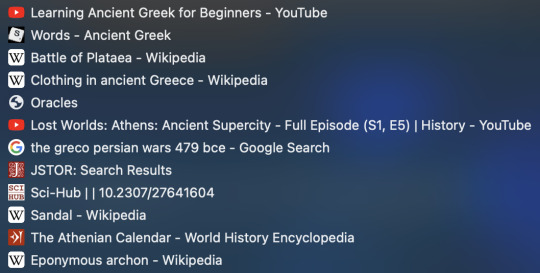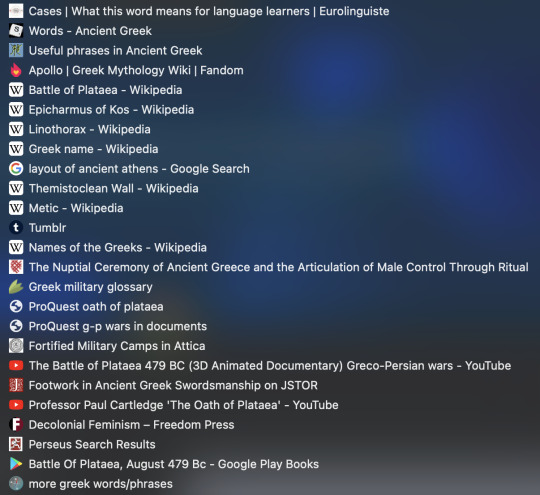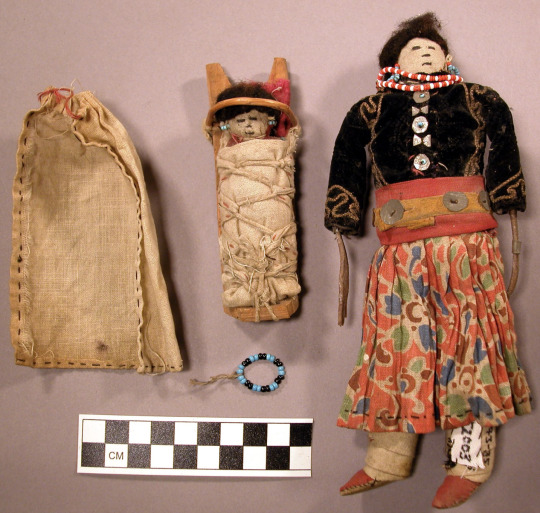#jstor wrapped
Explore tagged Tumblr posts
Text
JSTOR Wrapped: top ten JSTOR articles of 2023
Coo, Lyndsay. “A Tale of Two Sisters: Studies in Sophocles’ Tereus.” Transactions of the American Philological Association 143, no. 2 (2013): 349–84.
Finglass, P. J. “A New Fragment of Sophocles’ ‘Tereus.’” Zeitschrift Für Papyrologie Und Epigraphik 200 (2016): 61–85.
Foxhall, Lin. “Pandora Unbound: A Feminist Critique of Foucault’s History of Sexuality.” In Sex and Difference in Ancient Greece and Rome, edited by Mark Golden and Peter Toohey, 167–82. Edinburgh University Press, 2003.
Garrison, Elise P. “Eurydice’s Final Exit to Suicide in the ‘Antigone.’” The Classical World 82, no. 6 (1989): 431–35.
Grethlein, Jonas. “Eine Anthropologie Des Essens: Der Essensstreit in Der ‘Ilias’ Und Die Erntemetapher in Il. 19, 221-224.” Hermes 133, no. 3 (2005): 257–79.
McClure, Laura. “Tokens of Identity: Gender and Recognition in Greek Tragedy.” Illinois Classical Studies 40, no. 2 (2015): 219–36.
Purves, Alex C. “Wind and Time in Homeric Epic.” Transactions of the American Philological Association 140, no. 2 (2010): 323–50.
Richlin, Amy. “Gender and Rhetoric: Producing Manhood in the Schools.” In Sex and Difference in Ancient Greece and Rome, edited by Mark Golden and Peter Toohey, 202–20. Edinburgh University Press, 2003.
Rood, Naomi. “Four Silences in Sophocles’ ‘Trachiniae.’” Arethusa 43, no. 3 (2010): 345–64.
Zeitlin, Froma I. “The Dynamics of Misogyny: Myth and Mythmaking in the Oresteia.” Arethusa 11, no. 1/2 (1978): 149–84.
#alphabetical order. im not ranking them#i still have two more froma zeitlin essays to read (one new and one a reread) in the next few days though#and its possible one of those might knock amy richlin off the rest (nothing personal; its a great piece just not my area)#but if im willing to have two things by the same scholar i would have to rethink including grethlein 'the poetics of the bath in the iliad'#some of my favorite articles/book chapters of the year are not on jstor though...#bill beck 'lost in the middle: story time and discourse time in the iliad'!!!#and lyndsay coo has a 2020 chapter updating and expanding this 2013 article that is 🔥🔥🔥#and of course judith mossman 'women's voices in sophocles' which is what send me to garrison 1989 and rood 2010 but is not itself on jstor#i also reread some of melissa mueller's objects as actors book which is wonderful as always#and i would be incredibly tempted to put william m calder iii's tereus article on a top ten list for sheer entertainment value#jstor wrapped#mine
498 notes
·
View notes
Text
JSTOR Wrapped? For You page?
Hi everyone! This is a call for feedback from all of you.
The product team here at JSTOR is wondering what user insights you'd like to see as part of your personal profile pages that you currently aren't able to see on the JSTOR platform.
Feel free to let us know: What would y'all like to know about your activity on JSTOR?
#adding this tag to make it known that these are things that have been requested from users so we'd like to know more! not set in stone#jstor#research#jstor wrapped#for you page#user insights#product feedback
152 notes
·
View notes
Text
2023 JSTOR Wrapped: top ten JSTOR articles of 2023
(via @finelythreadedsky)
Greenwood, L.H.G. “The Shape of Greek Tragedy.” Greece & Rome, Vol. 6, No. 16 (Oct., 1936), pp. 31-40.
Donald, Mills H. “ODYSSEUS AND POLYPHEMUS: TWO HOMERIC SIMILES RECONSIDERED.” The Classical Outlook, Vol. 58, No. 4 (MAY-JUNE 1981), pp. 97-99.
Ebbott, Mary. “Tell Me How It Hurts: An Intersection of Poetry and Pain in the “lliad”.” New England Review, Vol. 37, No. 2 (2016), pp. 31-46.
Kitts, Margo. “SACRIFICIAL VIOLENCE IN THE ILIAD.” Journal of Ritual Studies, Vol. 16, No. 1 (2002), pp. 19-39.
Kitts, Margo. “KILLING, HEALING, AND THE HIDDEN MOTIF OF OATH-SACRIFICE IN ILIAD 21.” Journal of Ritual Studies, Vol. 13, No. 2 (1999), pp. 42-57.
Blondell, Ruby. ““Bitch That I Am:” Self-Blame and Self-Assertion in the Iliad.” Transactions of the American Philological Association (1974-2014), Vol. 140, No. 1 (Spring 2010), pp. 1-32.
Hame, Kerri J. “Female Control of Funeral Rites in Greek Tragedy: Klytaimestra, Medea, and Antigone.” Classical Philology, Vol. 103, No. 1 (January 2008), pp. 1-15.
Norcia, Megan A. “The Imperial Food Chain: Eating as an Interface of Power in Women Writers' Geography Primers.” Victorian Literature and Culture, Vol. 33, No. 1 (2005), pp. 253-268.
King, C. Richard. “The (Mis)uses of Cannibalism in Contemporary Cultural Critique.” Diacritics, Vol. 30, No. 1 (Spring, 2000), pp. 106-123.
Tucker, Aviezer. “Sins of our Fathers: A Short History of Religious Child Sacrifice.” Zeitschrift für Religions- und Geistesgeschichte, Vol. 51, No. 1 (1999), pp. 30-47.
17 notes
·
View notes
Text
Me: Ok, I'm on the last chapter of the amnesia fic extended cut. It's all porn from here on out. Easy peasy.
RECORD SCRATCH
The plot bunnies: Hey, what if instead you spent the forseeable future researching the historical eras of Korea and corresponding folklore to write an absolute fucking saga spanning the entirety of Korea's populated existence?
#what?#no!!!#*four hours on JSTOR later*#make it stoooooop#My mom has hardware cloth covering every hole in her fence to prevent rabbits from getting in (she HATES them)#maybe i need to ask her to wrap my head in hardware cloth to keep the plotbunnies out#gahan#the devil judge
7 notes
·
View notes
Text
My secondary sources
Hello! I’d like to take a moment to share my secondary sources for my research project on popular music as a means of protest during the Troubles in Ireland.
To begin with, I plan to use a few chapters from Negus, An Introduction to Popular Music, especially chapter 7 (Politics) and chapter 6 (Geographies). Chapter 7 will help me explore how music directly contributed to protest movements and political mobilization, while chapter 6 can show how music moved across borders and helped create a global consciousness about the conflict (I may also refer to chapter 3 and chapter 1). But that's enough about Negus—let’s dive into other secondary sources.
Another book I plan to use is Made in Ireland, but only its chapter entitled “Popular Music as a Weapon: Irish Rebel Songs and the Onset of the Northern Ireland Troubles” (everything is in the title).
Since I’m a podcast enthusiast, I’ve found one that I believe is particularly relevant to my topic. It is called "Music of the Troubles" and is from RTE radio 1 :
I’m also considering including micro-analyses from the documentary The Troubles: A Secret History (from the BBC). Although it doesn’t focus only on music, the series evokes it a lot, especially in relation to the political and social context of the Troubles.
Additionally, I’ve found an article from JSTOR that could complement my research (though I’m still struggling to access full-text version) :"The Cultural Impact of Music During the Troubles in Northern Ireland".
Finally, I thought it was relevant to mention the SONIC archive site, which I am still browsing. This website contextualises a lot political songs during and after the ‘Troubles’ (1968-98), whis is very helpful.
To wrap things up, I’ve started to embrace the challenge: I’m getting even more passionate about it! Below is a recap table created on Canva of my sources at the moment (I've also added some interviews as primary sources) :

Thanks for reading and good luck with your investigations!
Annah
15 notes
·
View notes
Note
3, 5, 13, and 24 for the reading wrap-up tag :) also bestie 50 books is very impressive for your final year of undergrad
(reading asks) starting the year off right by remembering to check my inbox like a big girl! hi pheobe thank you <3 i’m fairly proud of my fifty-something books (exact counts are hard because I am a chronic rereader). i wanted to keep doing things i enjoyed so i didn’t go completely crazy; a not-insignificant amount of them were children’s or middle grade books, because I wanted to keep things attainable and enjoyable
3. What were your top five books this year?
In reverse-chronological order of reading:
The Return of the Thief by Megan Whalen Turner (eugenides i love you)
The Goblin Emperor by Katherine Addison (which i finished and immediately flipped over to reread)
White Oleander by Janet Fierch (toxic mother-daughter relationships my beloved)
Fox’s Tongue and Kirrin’s Bone by Allison Kovacs (don’t u love it when a narrator trusts everyone so little that he blatantly withholds information from you)
Piranesi by Susanna Clarke (book that had me reading ten jstor articles about it, for fun)
The Raven Cycle was also amazing but the whole series felt like an Experience, and I don’t think I loved any one volume overmuch
5. What genre did you read the most of?
While I try to read broadly (especially since my title-selection process largely leans “what is cheapest at the used bookstore”) fantasy always is and always will be my first love and a full half of the books I read had a fantastical element. I am a simple creature, I like it when magic
13. What were your least favorite books of the year?
The Changelling by Viktor Lavelle (i think i spelt that wrong) (i’m writing this while i don’t have service so i cannot google it) wasn’t the worst book I read this year but it was definitely my least favourite reading experience and I don’t know why I even finished it. I kept reading another chapter thinking “surely it’ll come back around” and it never did”. I can’t even tell you what it’s about because the biggest issue I had was the way it like?? Switched genres about six times??
It started out as a mostly-realistic, really touching portrait of the anxieties and dangers of modern parenting, and ended with a guy who had?? A troll?? Like a troll from scandinavian mythology that he kept in a cave on the family land and fed kidnapped babies to?? And he livestreamed this online in a sort of metaphor for internet trolls and a cautionary tale against over-posting your kids on facebook? I don’t even know. I felt very confused and betrayed by the end.
What was probably the WORST book I read this year was The Wrath and the Dawn (which I reviewed here) but I knew going in that it would be bad and so it made a very fun reading experience.
24. Did you DNF anything? Why?
My only DNF this year was The House of Rust by Kadija Abdalla Bajaber, and it was a very its-not-you-its-me type situation. It’s a fabulist novel about a girl searching for her missing fisherman father, with Kenyan folklore blurred in, and the prose was absolutely beautiful but boy did this take me a good two months to slog through until I finally gave up at like 60%. I think the prose was so rich it sometimes got in the way of the actual storytelling (to the point where I sometimes couldn’t tell what was a literal fantastical happening and what was just a simile or metaphor) and I often just. Had no idea what was happening. I’m sorry House of Rust I wish I could have loved you :(
3 notes
·
View notes
Text
JSTOR wrapped:
you found 30 new papers you want to read in your free time!
you spent 50 hours looking up random subjects!
your most-searched subject is homosexuality in medieval monks!
you read 0 full papers!
5 notes
·
View notes
Note
read chap 3-13 of theogeny this morning since i was free until 2pm (wanted to wait until it was complete before starting, and did 1-2 last night since i had some time). very nice story! the tone and style of your writing feels totally professional (and honestly surpasses many published authors i’ve read LOL). however, i was especially blown away by all of the historical details about ancient athens & greece. i’m as close to the opposite of an expert on the time period as possible, thus am not fully convinced this isn’t based on a true story where you got sent back in time, but then chose to come back to the present afterwards. were there any sources you leaned particularly heavily on? even my own experience writing a gen-ed history paper about the original Olympic games during my undergrad felt about as straightforward as navigating a swamp of hopelessly entangled, greek-speaking, arguing jellyfish, what with all the completely speculative secondary sources and glaring holes in the firsthand accounts of the events.
i’ve been away from the depths of the hp fandom scene for a year or two, but my recollection of your blog was that you’re a law student? given that law ≠ classical greek history (as far as i know), i’d say the fact that you specifically researched all of this for the story makes it even more captivating. (although the attention to detail does also align exactly with the depth of case-research i’d assume is possessed by the top-tier, most competent lawyers, though that is purely speculation). but if your real answer is the time travel thing, just blink twice and cite wikipedia or whatever ;)
also, i’m curious how realistic it is for a classics scholar to know enough ancient greek that she can carry even a stilted conversation with native speakers. if so, i find it mind-blowing that such depth of knowledge of a dead language is wrapped up into a subset of a history PhD—makes my own discipline seem like 3rd grade times tables.
LOL thank you so much! this is such a wonderful, detailed review! I can safely say that I have not traveled back to ancient Athens, but if there's any way I can visit for about a day and then return to the modern era please LMK…
so: I tended to use a lot of sources from Google Scholar, JStor, my own university's online library, what have you; there are a few times I went back and read through my old Classical Civilizations lecture notes, but I only ever took an intro class so I wasn't exactly delving into the minutiae. many of the sources are listed in the end notes, but I have an entire bookmarks folder (which I should probably delete) that looks like this lol


of course, I had to suspend my disbelief and expect/hope the reader would suspend their disbelief at the things that I just couldn't really know; but that was my moment for artistic liberty, which I used a lot of let me tell you.
and yes! I'm a second year law student. but I started this story when I was still applying to law schools :") I have worked as an archival and online research assistant/hired researcher/research fellow since I was 19 in my undergrad days, so I've become very familiar with the process of sifting through online archives. I also just really enjoy it! I love learning about areas of history I don't know a lot about, so this was just such a perfect passion project.
so — in terms of speaking Ancient Greek, I think it's absolutely possible that students at the PhD level would be able to communicate, given that many programs have really robust Greek language curricula. however, and this is something I touched on in the early chapters and something I researched to the best of my ability, the way that academic accents from non-Greek native speakers (aka, modern Greek people) sound is very different in pronunciation and would likely sound strange and unnatural to someone in Ancient Greece; such is the nature of language development. so, I think would have been pretty much like any non-fluent language speaker being thrown into an immersive program with no preparation.
I'm not here for any discipline ribbing, though! I'm sure whatever it is you study is just as challenging and engaging as Lily's field :)
6 notes
·
View notes
Text
jstor wrapped
[i nabbed this from someone and i have no idea who. bad memory wins again]
Büscher, Bram, Robert Fletcher, Dan Brockington, Chris Sandbrook, William M. Adams, Lisa Campbell, Catherine Corson et al. "Half-Earth or Whole Earth? Radical ideas for conservation, and their implications." Oryx 51, no. 3 (2017): 407-410, https://www.cambridge.org/core/journals/oryx/article/halfearth-or-whole-earth-radical-ideas-for-conservation-and-their-implications/C62CCE8DA34480A048468EE39DF2BD05. (weirdly, not on jstor.)
Cronon, William. “The Trouble with Wilderness: Or, Getting Back to the Wrong Nature.” Environmental History 1, no. 1 (1996): 7–28. https://doi.org/10.2307/3985059.
Dressler, Wolfram. “Capitalizing Conservation on Palawan Island, the Philippines.” In Nature Inc.: Environmental Conservation in the Neoliberal Age, edited by Wolfram Dressler, Bram Büscher, and Robert Fletcher, 25–43. University of Arizona Press, 2014, https://www.jstor.org/stable/j.ctt183pdh2.4. (this ones a book chapter whoa!)
Harlan, Jack R., and J. M. J. deWet. “Some Thoughts about Weeds.” Economic Botany 19, no. 1 (1965): 16–24. http://www.jstor.org/stable/4252561.
Honorable mentions:
DENEVAN, WILLIAM M. “THE "PRISTINE MYTH " REVISITED.” Geographical Review 101, no. 4 (2011): 576–91. http://www.jstor.org/stable/23208640.
Haddock, Joanna K., Caragh G. Threlfall, Bradley Law, and Dieter F. Hochuli. "Light pollution at the urban forest edge negatively impacts insectivorous bats." Biological conservation 236 (2019): 17-28.
2 notes
·
View notes
Text
2023 JSTOR Wrapped
(via @en-theos)
Top 5 JSTOR articles I read for the first time this year:
Coo, Lyndsay. “A Tale of Two Sisters: Studies in Sophocles’ Tereus.” Transactions of the American Philological Association (1974-2014) 143, no. 2 (2013): 349–84. http://www.jstor.org/stable/43830266.
Finglass, P. J. “A New Fragment of Sophocles’ ‘Tereus.’” Zeitschrift Für Papyrologie Und Epigraphik 200 (2016): 61–85. http://www.jstor.org/stable/26603863.
Grethlein, Jonas. “Eine Anthropologie Des Essens: Der Essensstreit in Der ‘Ilias’ Und Die Erntemetapher in Il. 19, 221-224.” Hermes 133, no. 3 (2005): 257–79. http://www.jstor.org/stable/4477658.
McClure, Laura. “Tokens of Identity: Gender and Recognition in Greek Tragedy.” Illinois Classical Studies 40, no. 2 (2015): 219–36. https://doi.org/10.5406/illiclasstud.40.2.0219.
Rood, Naomi. “Four Silences in Sophocles’ ‘Trachiniae.’” Arethusa 43, no. 3 (2010): 345–64. http://www.jstor.org/stable/44578344.
Top 3 JSTOR articles I revisited this year:
March, Jenny. “Vases and Tragic Drama: Euripides’ Medea and Sophocles’ Lost Tereus.” In Word And Image In Ancient Greece, edited by N. Keith Rutter and Brian A. Sparkes, 119–39. Edinburgh University Press, 2000. http://www.jstor.org/stable/10.3366/j.ctt1r249k.14.
Purves, Alex C. “Wind and Time in Homeric Epic.” Transactions of the American Philological Association 140, no. 2 (2010): 323–50. http://www.jstor.org/stable/40890982.
Zeitlin, Froma I. “The Dynamics of Misogyny: Myth and Mythmaking in the Oresteia.” Arethusa 11, no. 1/2 (1978): 149–84. http://www.jstor.org/stable/26308158.
#harder than i expected bc lots of my favorite articles (and especially my favorite rereads) are not in fact on jstor#might do a separate top ten jstor articles of the year#mine#jstor wrapped
121 notes
·
View notes
Text

Spotify Wrapped dropped today, and what better way to celebrate than a little bit of research?
This open access article discusses the digitization of media, including how it came to be and its benefits to media enjoyers.
Want to know what we're listening to at JSTOR? Here's a mixtape with a few songs devised by JSTOR Daily.
🖼️ : Bartholomeus van der Helst (Dutch, Haarlem, born ca. 1612–15, died 1670 Amsterdam). The Musician. 1662. Oil on canvas. The Metropolitan Museum of Art.
#spotify wrapped day is the only day that matters to me#it is my identity.#jstor#research#spotify wrapped#open access#music#media
382 notes
·
View notes
Quote
Navigators in the Marshall Islands faced a unique challenge. The tiny islands and coral atolls they traveled between are mostly too low and small to be seen from more than ten miles away, so voyaging meant finding one’s way through a seemingly featureless expanse of open sea. If you were just a little bit off, you might completely miss your destination. Faced with this challenge, islanders developed an ingenious solution: navigating by the feeling of the waves. This uniquely proprioceptive mode of navigation required the navigator to remain constantly aware of the motions of ocean swells coming from four directions. The eastern swell was the strongest, which allowed them to orient themselves. They could detect the way a swell would change when it wrapped around an island or bounced back against a cliff, for instance. These distinctive patterns could be followed to land in the same way “the root, if you follow it, leads to the palm tree.” This is the mental model that the wave charts reflect: they show the sea as a kind of spiderweb, full of communicative tremors. Wave charts aren’t maps so much as mnemonic devices. They’re not brought on board in order to navigate; rather, the navigator makes them as a personal reference, studying them while on land and bringing that knowledge onto the sea. There were a few different kinds: rebbelib, which represented whole island chains; meddo, which showed ocean swell patterns in a smaller area; and mattang, simple teaching tools used to diagram the basic interactions between land and sea.
“Marshall Island Wave Charts” from JStor Daily
6 notes
·
View notes
Text

Doll: baby in typical carrying frame; Doll of Navajo woman, fabric body & clothes, wool hair, bead & metal jewelry. Fabric; Wood; Wool; Glass bead; Metal; Leather. 11.7 cm x 4.1 cm x 4.1 cm; 20.3 cm x 8.1 cm x 4.3 cm
This image shows two handmade dolls, featuring a Navajo woman and a baby in the typical carrying frame. Both dolls have hair made of wool and are wearing beaded and metal jewelry. Though the work is undated, one can assume it was made during the mid-1800s from the woman’s dress and the doll’s stylistic traits. Dolls in this era were usually made to be sold to tourists, or sometimes for personal use as a way to maintain cultural heritage and show the daily life of a Navajo community member. Some of these dolls were also used as fashion inspiration for Navajo women, much like how the European fashion dolls of the 16th century were used to advertise pieces by designers for clients overseas without having to paint it (like a prototype of sorts). Navajo women and European women influenced each other’s styles in this era; European wives would go back to their homes with Navajo style clothing and vice versa sometimes. For example, some Navajo women were inspired by the maximalist use of satin in Europe and incorporated it into their dress (or substituting it with velvet), personalizing it with silver and coin buttons. The moccasins, leg wraps, floral skirt, and wide belt are also typical of Navajo dress in this time.
Though some Navajo dolls were meant to be sacred or instructional (and the excavation of them deeply upset local communities for possibly inflicting harm on themselves), these dolls seem to be more recreational, meant to be played with or collected, as they are not decorated like kachina dolls, which would have a more instructive role in teaching children the nation’s mythology. Additionally, the presence of the baby doll lends itself to the idea that this work was more showing cultural and daily life, and was meant to be collected/shared rather than revered.
SOURCES:
Spain, James N. “Navajo Culture and Anasazi Archaeology: A Case Study in Cultural Resource Management.” Kiva, vol. 47, no. 4, 1982, pp. 273–78. JSTOR, http://www.jstor.org/stable/30247346.
0 notes